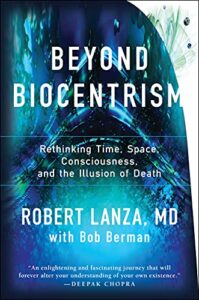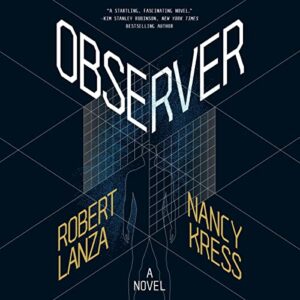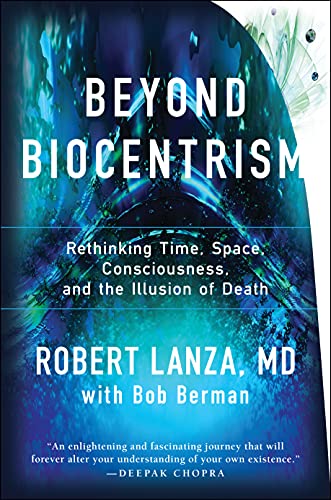I’ve read rave reviews of Robert Lanza’s and Nancy Kress’ science fiction novel, Observer. After learning that it is based on Lanza’s theory of biocentrism, I decided to first read one of his recent books on the subject before reading the sci-fi novel. Below is my review of Beyond Biocentrism by Robert Lanza and Bob Berman.

In reading Robert Lanza’s and Bob Berman’s Beyond Biocentrism, the 2017 follow-up to their 2010 best-selling Biocentrism, I had the feeling that I was listening to the epiphanies of a college sophomore who’d just taken their first science and philosophy classes. The first several chapters basically repeat and repeat the idea that modern science has admitted that they not only know nothing about true reality, but their materialistic paradigm, the “classical” worldview, we are all taught, is a dead end when it comes to genuine understanding. As an avid consumer of astronomical, physical, and biological science, I know, and I’m sure that the authors do too, that “modern science” has admitted no such thing. In fact, it’s alive and well, and much of the work in quantum mechanics and cosmology is to find ways to integrate new and surprising findings with the classical worldview.
The bulk of the book is a compendium of findings and experimental results from a wide variety of areas, including quantum theory, astronomy, neuroscience, and even plant behavior. Curiously lacking, for a book that claims to show how understanding consciousness can explain everything in the universe as well as the universe itself, are any reference to studies of consciousness, a vibrant and active field of research within neuroscience, cognitive science, and philosophy. Not even any major theories of consciousness, such as Bernard Baars’ Global Workspace Theory are mentioned. There is a passing and dismissive reference to Daniel Dennett’s 1991 book, Consciousness Explained, complaining that it ignores consciousness and only discusses the brain, which the authors contend has little to do with real consciousness.
The book’s argument seems to go this way: we know that “quantum effects” such as superposition and decoherence in the double slit experiment are dependent upon an observer. They claim that other aspects of quantum theory, such as the “spooky” nature of quantum entanglement, in which objects at any distance from each other simultaneously react to each other in complementary fashion, show that both space and time are illusions. Given such findings, the only way to reconcile them in a scientific way, according to them, is to conclude that all reality is a construction of consciousness (many, if not most, researchers of these phenomena don’t talk about consciousness or observers “knowing” the events, they talk about measuring them*). They throw in a few more bits of research from other fields, such as the studies of “blindsight,” that show a person able to detect objects without consciously “seeing” them after damage to the primary visual cortex, or studies of plants’ complex defenses and signaling behavior to each other. I’m quite familiar with these studies. None of the researchers studying these phenomena suggest they indicate a pervasive consciousness that exists beyond the human body and constructs the world, and Lanza and Berman don’t give convincing evidence that these phenomena are even relevant to their argument.
Now, the quantum theory findings are intriguing and admittedly not explained by classical physics. Likewise, it’s true that the world we perceive and react to is one constructed inside our brains and is far different than the real world “out there.” We see colors and they don’t exist outside our brains, neither do words, nor is the way we spatially perceive the world necessarily the way it is. Kant understood this; all modern brain scientists do too. What we perceive is one way of characterizing reality and it is a way that our brains choose to do it because it reflects the limits of our sensory organs and a picture of the world that allowed survival of our prehistoric ancestors, including even before humans. For it to work, it had to have some correlation with what was really out there. Lanza and Berman say as much, but their conclusion is that what is out there doesn’t exist in any form except as an entity in our consciousness.
A big difficulty with the theory of biocentrism is that the authors give no hint at what kind of evidence would prove it false. As they, themselves, conclude about string theory after accusing it of the same defect, that makes it untenable as a scientific theory. That, and their lack of definition of consciousness or effort to incorporate current consciousness research, seriously weaken their argument. They also commit a host of logical mistakes. After a gesture in the direction of computing the probabilities associated with the universe producing life on its own out of pure random association of basic elements, they conclude that it’s statistically impossible for life to have arisen spontaneously by chance. This is the lottery winner’s fallacy (similar to the “survivorship bias”) in which the person whose lottery ticket is chosen out of millions of possible winners says the probability of being the winner was so small that it was impossible for them to have been the one chosen. Reasoning backward from a single unlikely event only tells you that it was unlikely, but to conclude it couldn’t happen, is a mistake. Also, such probability estimates assume that every option has an equal chance of happening, as in the lottery, but in creating life on at least one planet, the probability of interactions between basic building blocks were not all equal or even all possible. If we exist on earth, as we do, then the probability of that happening isn’t relevant, although it may determine the likelihood that life has arisen not just here, but elsewhere, too.
Another problem is the “the world is held aloft by elephants standing on the back of a turtle” problem: what holds up the turtle? If the big bang doesn’t work because we don’t know where it came from, then “the universe is made up from our consciousness” has the same problem of answering where consciousness came from if it created everything else. They solve this problem by eliminating time so that there is no before consciousness existed and no after. Unfortunately, this doesn’t solve the problem of where it came from, and by the way, it eliminates their objection to the big bang theory as not specifying what was before the bang. A more general answer that conscious just is—everywhere and at all times—sounds a little too much like explanations that invoke God. Finally, while the book clearly states that neural circuitry produces our perceptions, it simultaneously appears to say that our consciousness creates our neural circuitry. What science definitely has shown, is that our conscious experience is dependent upon our brain. Our level of consciousness can be altered by drugs, surgery, or injury, and how we experience things is also altered, often in bizarre ways, by various brain injuries and diseases. We have virtually no evidence that consciousness persists after the death of a brain.
The basic problem with biocentrism is that it highlights some scientific conundrums that appear to and probably do challenge our basic classical view of the universe. It takes those problems and, instead of acknowledging that they are puzzles, says the answer is a kind of universal, timeless consciousness, the characteristics of which are undefined, and which nullifies real existence to everything in the material world and says it’s all a product of consciousness. How would you know if that’s a correct theory? So far, the authors have provided no way to prove it one way or the other. They hint that much of the evidence may be “intuitive” rather than “scientific,” yet say, “our biocentric conclusions that there is no death, no time, no space, and instead a single living entity, which precludes a stand-apart universe abiding separately from life and consciousness, is a science-based reality.” This is a broad statement, and I don’t know of any body of scientific research that actually supports it. Beyond Biocentrism certainly doesn’t provide one. To start with the well-known fact that what we perceive about the world is produced by our brains and is not a picture of what’s actually there, and end with the conclusion that, in fact, nothing is there, is a bridge too far.
What Lanza and Berman have done is use confusing language to befuddle their readers with statements such as “That frame of art hanging “over there” across the room is actually inside your head.” Yes, the visual image produced by light reflected from the frame of art is “inside your head,” as is its identity as a picture frame, but in what sense can you say that the actual object is? If you walk across the room (actually go “over there”) you can touch it, smell it, and pick it up to see how heavy it is. You can’t do anything like that standing where you are and examining the visual image. Yes, all those perceptions are also inside your head, but, if someone removes the object from the room, you will no longer have them, much less the visual image. What is on the wall is atoms arranged into elements configured as molecules of substances modified by humans, that when perceived by humans evokes the visual image of a picture frame. What is getting mixed up is what is meant by the “frame of art.” Something is hanging on the wall or we wouldn’t have the experience at all. Your perceptions and the object that produces them are not the same thing and acknowledging that one exists (the image inside my head) does not mean the other one doesn’t. Does the something on the wall look like the image in your head? Well, Lanza and Berman are right that “what it looks like” is a phrase that only applies to visual images in our heads, not to objects on walls, because they don’t look like anything in themselves—only to someone who sees them. That doesn’t remove them from reality.
While I wasn’t impressed with the arguments in Beyond Biocentrism, I was entertained. The book is very well written and very clever, even humorous in several instances, and the various discussions of quantum effects were highly interesting. As I said, I only read the book so I would have a background for reading  Observer, Robert Lanza’s and Nancy Kress’ science fiction novel. Good science fiction doesn’t require unassailable science and I’ve read plenty of excellent science fiction books that relied on totally unproven science (warp drives, jump gates, etc.). I’ve even used some of these ideas myself. After reading Beyond Biocentrism, I’m even more eager to read Observer, and what I have learned, is that I’ll probably enjoy it more if I keep my scientific skepticism under wraps, and let my imagination enjoy the ride.
Observer, Robert Lanza’s and Nancy Kress’ science fiction novel. Good science fiction doesn’t require unassailable science and I’ve read plenty of excellent science fiction books that relied on totally unproven science (warp drives, jump gates, etc.). I’ve even used some of these ideas myself. After reading Beyond Biocentrism, I’m even more eager to read Observer, and what I have learned, is that I’ll probably enjoy it more if I keep my scientific skepticism under wraps, and let my imagination enjoy the ride.
* Beyond Biocentrism misleads the reader about what constitutes an “observer” in experiments such as the double slit experiment. The observer need not be human and the same decoherence effects are seen with automated and electronic registering of the results. Observing, whether prior to entering the slit or afterwards, also requires using some kind of apparatus to reveal the photon or electron by interacting with it; it is not passive observation. This interaction, which is part of what is meant by “measuring” the result, is enough disturbance to cause decoherence. In fact, that is the standard explanation of how quantum effects that appear to require measurement could have happened before conscious beings existed. Interactions between primordial subatomic particles were sufficient to cause the quantum waves to “collapse.” The authors of this book use cartoons to show people watching the results of the experiment to illustrate observation, which is misleading. Highly cited results by Radin et al, which are purported to show that merely having people attend to the experiment will produce decoherence have been called into question by recent replication of the studies showing that the tiny effects of attention are more likely to be false positive results, i.e., statistical artififacts.
Can an AI be superintelligent, and if so, should we fear it? Read Casey Dorman’s novel, Ezekiel’s Brain on Amazon. Available in paperback and Kindle editions
Rather listen than read? Download the audio version of Ezekiel’s Brain from Audible.
Subscribe to Casey Dorman’s Newsletter. Click HERE







Thanks Casey. This is all way over my head, but interesting nevertheless. I enjoyed Ezekial’s Brain. Scary, but timely. I’m reading a 600 page history of Portugal (in English) right now, but will get back to Sci-fi after I finish it. Like modern scientists, physicists, philosophers, sci-fi writers, Portuguese mariners in the 15th and 16th centuries, encouraged and financed by multiple Portuguese governments, pushed the boundaries of the known world as they worked their way south down the coast of Africa.
Thanks, Casey. I am just starting to learn about biocentrism and am going to the library tomorrow to pick up the book that you just mentioned. It is also fun that someone else interested, Terry Spring, was a classmate from the beginning, firstgrade at Salmon Creek. (And with Pete since junior high). Please keep me in your loop.